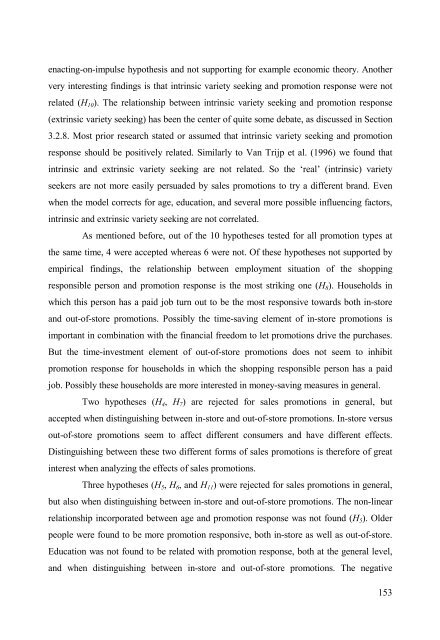Analysis of Sales Promotion Effects on Household Purchase Behavior
Analysis of Sales Promotion Effects on Household Purchase Behavior
Analysis of Sales Promotion Effects on Household Purchase Behavior
Create successful ePaper yourself
Turn your PDF publications into a flip-book with our unique Google optimized e-Paper software.
enacting-<strong>on</strong>-impulse hypothesis and not supporting for example ec<strong>on</strong>omic theory. Another<br />
very interesting findings is that intrinsic variety seeking and promoti<strong>on</strong> resp<strong>on</strong>se were not<br />
related (H10). The relati<strong>on</strong>ship between intrinsic variety seeking and promoti<strong>on</strong> resp<strong>on</strong>se<br />
(extrinsic variety seeking) has been the center <str<strong>on</strong>g>of</str<strong>on</strong>g> quite some debate, as discussed in Secti<strong>on</strong><br />
3.2.8. Most prior research stated or assumed that intrinsic variety seeking and promoti<strong>on</strong><br />
resp<strong>on</strong>se should be positively related. Similarly to Van Trijp et al. (1996) we found that<br />
intrinsic and extrinsic variety seeking are not related. So the ‘real’ (intrinsic) variety<br />
seekers are not more easily persuaded by sales promoti<strong>on</strong>s to try a different brand. Even<br />
when the model corrects for age, educati<strong>on</strong>, and several more possible influencing factors,<br />
intrinsic and extrinsic variety seeking are not correlated.<br />
As menti<strong>on</strong>ed before, out <str<strong>on</strong>g>of</str<strong>on</strong>g> the 10 hypotheses tested for all promoti<strong>on</strong> types at<br />
the same time, 4 were accepted whereas 6 were not. Of these hypotheses not supported by<br />
empirical findings, the relati<strong>on</strong>ship between employment situati<strong>on</strong> <str<strong>on</strong>g>of</str<strong>on</strong>g> the shopping<br />
resp<strong>on</strong>sible pers<strong>on</strong> and promoti<strong>on</strong> resp<strong>on</strong>se is the most striking <strong>on</strong>e (H8). <strong>Household</strong>s in<br />
which this pers<strong>on</strong> has a paid job turn out to be the most resp<strong>on</strong>sive towards both in-store<br />
and out-<str<strong>on</strong>g>of</str<strong>on</strong>g>-store promoti<strong>on</strong>s. Possibly the time-saving element <str<strong>on</strong>g>of</str<strong>on</strong>g> in-store promoti<strong>on</strong>s is<br />
important in combinati<strong>on</strong> with the financial freedom to let promoti<strong>on</strong>s drive the purchases.<br />
But the time-investment element <str<strong>on</strong>g>of</str<strong>on</strong>g> out-<str<strong>on</strong>g>of</str<strong>on</strong>g>-store promoti<strong>on</strong>s does not seem to inhibit<br />
promoti<strong>on</strong> resp<strong>on</strong>se for households in which the shopping resp<strong>on</strong>sible pers<strong>on</strong> has a paid<br />
job. Possibly these households are more interested in m<strong>on</strong>ey-saving measures in general.<br />
Two hypotheses (H4, H7) are rejected for sales promoti<strong>on</strong>s in general, but<br />
accepted when distinguishing between in-store and out-<str<strong>on</strong>g>of</str<strong>on</strong>g>-store promoti<strong>on</strong>s. In-store versus<br />
out-<str<strong>on</strong>g>of</str<strong>on</strong>g>-store promoti<strong>on</strong>s seem to affect different c<strong>on</strong>sumers and have different effects.<br />
Distinguishing between these two different forms <str<strong>on</strong>g>of</str<strong>on</strong>g> sales promoti<strong>on</strong>s is therefore <str<strong>on</strong>g>of</str<strong>on</strong>g> great<br />
interest when analyzing the effects <str<strong>on</strong>g>of</str<strong>on</strong>g> sales promoti<strong>on</strong>s.<br />
Three hypotheses (H5, H6, and H11) were rejected for sales promoti<strong>on</strong>s in general,<br />
but also when distinguishing between in-store and out-<str<strong>on</strong>g>of</str<strong>on</strong>g>-store promoti<strong>on</strong>s. The n<strong>on</strong>-linear<br />
relati<strong>on</strong>ship incorporated between age and promoti<strong>on</strong> resp<strong>on</strong>se was not found (H5). Older<br />
people were found to be more promoti<strong>on</strong> resp<strong>on</strong>sive, both in-store as well as out-<str<strong>on</strong>g>of</str<strong>on</strong>g>-store.<br />
Educati<strong>on</strong> was not found to be related with promoti<strong>on</strong> resp<strong>on</strong>se, both at the general level,<br />
and when distinguishing between in-store and out-<str<strong>on</strong>g>of</str<strong>on</strong>g>-store promoti<strong>on</strong>s. The negative<br />
153

















